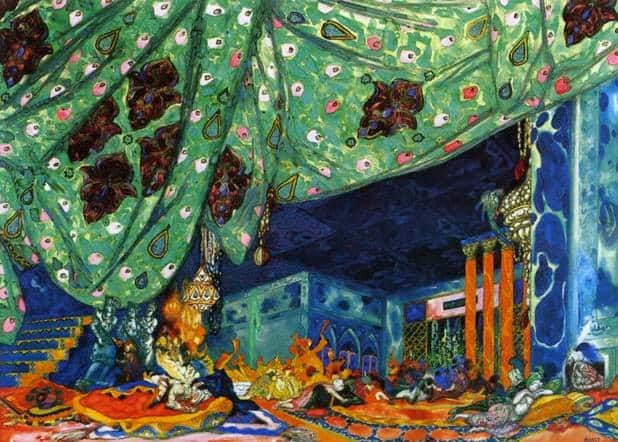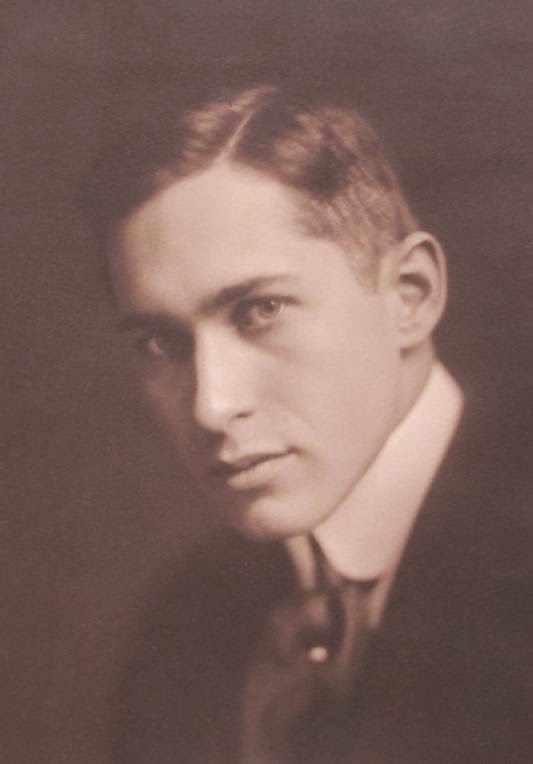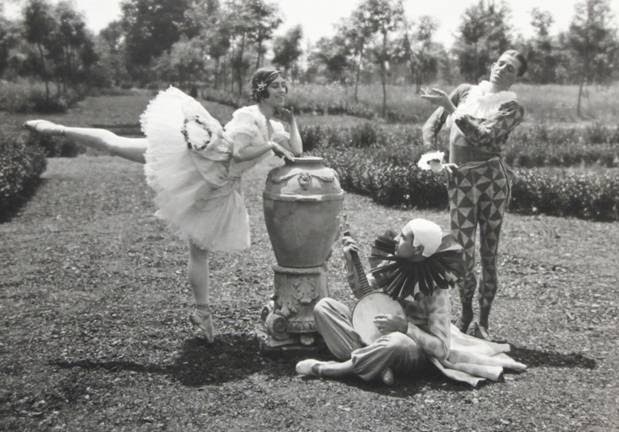Dance in Geneva
By Alice Askins, Education Coordinator at Rose Hill Mansion
 |
| Scheherezade and the Golden Slave from the Ballets Russes production of Scheherezade. |
During the 1910s and 20s the dance world was in ferment. In 1909 the Russian impresario Serge Diaghilev brought a new kind of ballet to Europe and the United States with the Paris debut of the Ballets Russes. The troupe was noted for the high standard of its dancers, who were classically trained at the great Imperial schools in Moscow and St. Petersburg. Their superior dancing enthralled Paris audiences.
Diaghilev developed a more complicated form of ballet, with showy and exotic elements intended to expand its appeal. He liked to tell his artists, “Astonish me.” He also encouraged exciting artistic collaborations among gifted young choreographers, composers, designers, and dancers. Works were commissioned from Stravinsky, Debussy, Picasso, Matisse, and Coco Chanel.
 |
| Set for Scheherezade created by artist Leon Bakst |
Many of Diaghilev’s dancers went on to found ballet traditions in the United Statesand Europe. George Balanchine, for example, created dances for the New York City Ballet. Others took the dance experience to smaller cities with smaller troupes. In 1921, one such company came to Geneva. The Daily Times reported on May 31, 1921:
BALLET RUSSE AT SMITH OPERA HOUSE
The Ballet Russe will be seen for the first time at Geneva, Friday evening, June 10th. On that occasion the magic of art for a fleeting hour wilI transform the Smith Opera House into the Royal Opera of an earlier Petrograd. Present and former members of the Pavlowa Ballet will contribute to the Soiree de Danse. These include such prominent artists as Mlle. Talma, Mlle. Saxova, Mlle. Sheffield, Mlle. Verina, M. Nicholoff and M. Gardner . . . The programme will be given under the auspices of the Hobart Centennial Fund Committee, the proceeds being devoted to the . . . Fund. The occasion will signalize the initial appearance here of Pavlowa’s associates. The performance will be invested with the delicate grace of Pavlowa and the elusive charm of Schischinska. [Pavlova and Kschessinskaya both danced in the Ballets Russes, and Pavlova later toured with her own company.]
The engagement is for a single evening only. Preceding the box office sale, tickets may be had at the Hotel Seneca and at Foster’s Book Store.
Geneva had something to add to this novel experience. The Daily Times announced on June 2 that Byron Nester [of the Nester Hotel family] would precede the performance with a talk at the High School about the “Art of Dancing.” Mlle. Talma of the troupe would “demonstrated the various movements . . . The control of muscles and the ability of the artist in executing the various steps as called by Mr. Nester, taking the part of the ballet master, proved intensely interesting.“ Mr. Nester also traced “The religious and historical significance of dancing, with its interpretation of the thoughts and feelings of the various peoples until the present so-called ballet d’action, expressing a high degree of dramatic art.”
 |
| Bryon Nester |
The Daily Times reported that the performance itself was “most pleasing,” and gave credit to Nester for the appearance of the troupe in Geneva.
The Ballet Russe was new to Genevaand most entrancingly diverting. . . Advance notices . . . had quite modestly kept Mr. Nester’s connection with the whole venture in the background, but no sooner had the first curtain risen than the evidences of his clever handwork came into view and the audience . . . realize[d] that it was he who had conceived and carried out the ballet . . .
The scenery and the costumes were designed by Mr. Nester and, as regards the scenery, some of the smaller portions . . . were even executed by his hand. The scenery . . . made a rich and picturesque setting for the various dances, and the costumlngs [sic] were daringly original, in colors that pleased the eye, harmonized with each other and with the stage settings and . . . were most artistic. The costumes were made by Mlle. Talma and M. Gardner from the color plate designs furnished by Mr. Nester.
. . . Each dance was a picture, a poem, a song, a dramatic interlude, a dream, a harmony in poetic motion, graceful rhythm and beautiful colorings. None but an artist of deep feeling could have carried out so perfect a conception.
Between the divisions of the program there was a demand from the audience for “Nester! Nester!” and Mr. Nester was finally obliged to come before the curtain, where he gracefully thanked the audience for the cordial support given him.
Nester had further plans for dance in his home town. The Daily Times reported in September 1921 that Nester:
Plans to Build Greek Theater
Geneva Art Lover Designs To Have Open Air Theater Near His Residence
The production of the “Ballet Russe” at the Smith Opera House . . . is part of a plan that Mr. Nester has long entertained for the advancement of dancing art in his home city. . . . he has been planning for several years to construct an open air theater on the grounds to rear of his residency . . . in South Main street. The grounds on the lake front of the estate provide the natural slope to make an ideal location for such a theater. Mr. Nester is contemplating a theater inspired by his own sketches of classical ruins . . . When this theater is completed, which will other distinguished artists who will quicken the interests of the people of the city in the best of terpsichorean, chore[o]graphic and dramatic art. . . .
As far as we know, the outdoor theater was never built. Perhaps Nester decided against it when he realized that an open air theater could be used only half the year in Geneva.
 |
| Unidentified dancers from the Nestor Family files at the Geneva Historical Society. |

Byron Nester was my uncle. Thanks for this information.